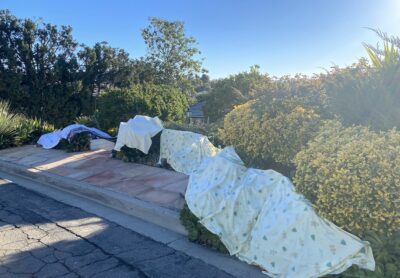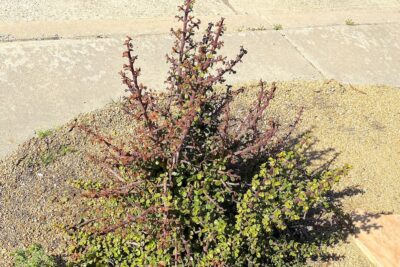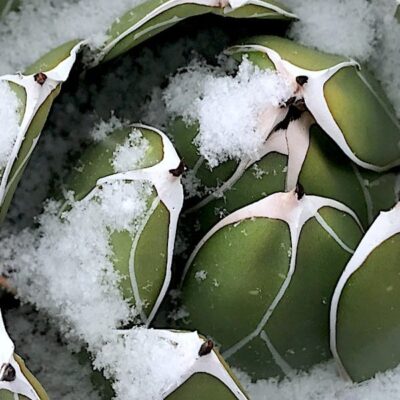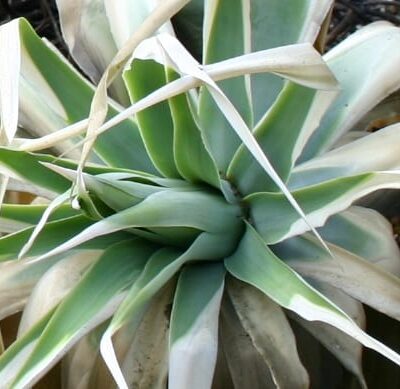Not good. This morning the birdbath was solid ice and lemons had frozen on the tree. Even those succulents I'd covered have patchy areas indicating damaged tissue. Those not covered (above) look worse.
Last night's forecast was 30 degrees, but parts of my garden likely went lower as cold air flowed and settled. Frost cloth and bedsheets added a few degrees, but it was the duration of the cold that made the difference.

It was windy while I was covering plants, so I secured sheets with clothespins.
Not all of this region---inland Southern CA---gets frost. Avocado and citrus orchards sit atop slopes so frost drains away. Hilltops often are fine at the same time valleys freeze.
Winter had been mild up to now. I was optimistic; I didn't think a late frost would be bad. Hopefully you saw frost advisories on the news and/or designer Laura Eubanks' social media post showing she'd covered her own garden.
So...how are your succulents? If you didn't cover them, is it too late? If there's damage, what's to be done?
You won't be able to tell the extent of the damage for a few days. That's time to rethink what-goes-where, and consider summer concerns as well.
Here on the cusp of frost, it often comes down to microclimates.
Case in point: After getting tired of covering them in winter, I grow crassulas only along my home's east-facing wall, beneath eaves. There they get morning sun, are protected from cold, heat, harsh sun and hail, and benefit from the wall's radiant warmth.
Dead and badly damaged plants will need to be removed.
If jades, kalanchoes and others turn brown and collapse, you probably don't want them.

This Portulacaria afra will look good again, once frost-burned branches are removed.
Wait until the weather warms---late March---then prune survivors back to healthy tissue. (Leave dead top growth for now; it helps insulate.) Spring works wonders, and plants will grow fast after late-winter rains.
Pruning is fine for shrub succulents like jades but not most aeoniums. Once a rosette freezes, leaves fall off, leaving naked stems. The good news is that succulent roots are shallow, and removal is quick: Yank-and-toss.
Trees are important inland
Speaking of Laura Eubanks...San Diego's best- known designer prefers not to plant under trees because leaf drop spoils a succulent garden's tidy aesthetic. That's smart along the coast, where temps range from the low 40s to the high 80s. But inland, trees serve to protect tender succulents from harsh weather.

The top of this jade is toast, but the plant's OK. Notice healthy growth at its base.
I have few deciduous trees because I want year-round canopies that moderate excessive sun, heat and cold. I've noticed that after succulents get a foot tall or fill in, leaves filter down through them. Under my oaks, hardscape is messier than planted areas. During hot weather, I blast with a hose those succulents with leaves in their crowns, like agaves and aloes. Year-round, I sweep (or blow) leaves from steps, patios and walkways.
Btw, I'm keeping my plants covered for a couple more nights, until lows are safely above the mid-30s. If you haven't covered yours, well, the worst is over, and (sad to say) once the damage is done, there's probably no point in doing so.
So, how did your garden fare during the frost?
Comments, questions, tips and suggestions welcome...but don't forget to mention your city or region. It matters!
Related Info on this site
Cold Hardy Succulents: Details, Photos and Varieties
Cold-Hardy Succulents: Details, Photos & Varieties Looking for succulents that go below freezing? You’re in the right place! About cold-hardy succulents The common cold-hardy succulents shown here can handle northern winters, snow, rainstorms (if given excellent drainage) and summer dry spells. Sedum (stonecrop) Trailing varieties are lovely as ground covers and in rock gardens, terraces and hanging…
Frost and Succulents: What You Need to Know
See the video Depending on how long temps stay below freezing (32 degrees F), “frost tender” succulents may show varying degrees of damage. When moisture in the cells of a vulnerable plant freezes, it expands, bursts cell walls, and turns leaves to mush. In a “light frost,” leaf tips alone may show damage (“frost burn”). In a “hard…
The post Oh, No, My Succulents Froze! appeared first on Debra Lee Baldwin. Copyright © Debra Lee Baldwin.
from Debra Lee Baldwin https://ift.tt/3eMzopv
via IFTTT



No hay comentarios:
Publicar un comentario